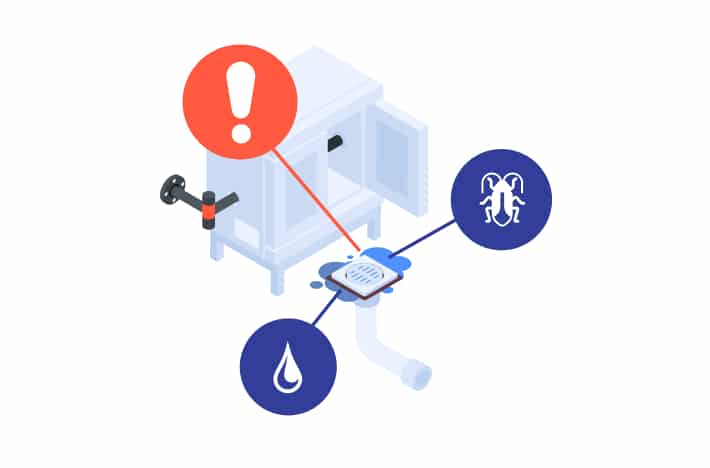Guest writer Cathy Goodwin is an expert FoodService Equipment Consultant with 35+ years of industry experience. She runs a highly successful Food Equipment Consultancy business, and her career has spanned fields ranging from hospitality to product development.
As part of my work in my consulting business, I regularly visit fast food restaurants, cafés and dine-in licensed restaurants. Generally, checking the drains is not part of my scope, however, the floor drain is something we all walk over regularly and probably don’t even think about. In my quest to find out more, I took it upon myself to do a little research, not a scientific kind of research, just the real life kind.
During recent site inspections, I saw a pattern emerging. Most of the kitchens had two or three drains in the back of house and one or two in the front of house, behind the counter. To my shock – none were clean. Putrid, in fact. How is this so? From my experience, unless staff are told and continually reminded, the unseen tasks will be overlooked or left until ‘another day’.
The cost of filthy floor waste drains
Flies, cockroaches, odours and expensive plumbing emergencies are just a few repercussions of filthy drains, not to mention potential food contamination. The floor waste and sink drains are the most common areas for unwanted pests to lay their eggs, so it won’t matter how clean the rest of your restaurant is – the pests will keep coming. The likely costs will include multiple expensive callouts to pest control, fewer customers due to mysterious smells and visible pests, and the loss of your restaurant’s reputation.
Passing on information and training for in-house cleaning and maintenance processes is essential. Staff need to understand why we have to perform certain tasks to grasp the importance of it.
What standards exist for floor waste drains?
In my quest for knowledge, I started hunting around for standards… which aren’t easy to find. I reached out to experts in the field – Brigette Green from Green Design Group, Marcel Heijnen from Stoddart Manufacturing, and David Berry from Eco Guardians – who were able to point me in the right direction.
According to Sydney Water’s guide on Plumbing for retail food businesses: “In addition to grease traps, you must install authorised in-sink and in-floor waste bucket traps in all prep sinks and floor wastes in all commercial kitchens and food preparation areas.”
The purpose being that the first grate stops large solids getting into the drain, the second removable basket catches the solids that got past the grate, and the last basket is a strainer to catch all the finer solids before the grease trap. All this is intended to stop contamination getting into the drain system.
How do you clean them and how often?
You can clean the grate and removable basket quite easily. At the end of each day, remove the grate to inspect if there is debris in the basket. If there is, remove it and empty any solids into your waste bin. Once all the solids are removed, thoroughly wash and dry the basket. Remove any solids from the secondary strainer by wiping them out and emptying into the waste bin. Then you can flush with water and replace the basket and grate.
The secondary strainer – which is fixed into position – the drain pipes and grease trap all need to be cleaned and serviced regularly by a trade professional. Another line of defense, where suitable, is to install Green Drains. These are drain trap seals to help protect against odours, gases, and bugs.
The key is to know what to ask and who to ask. Always engage and work with professionals, not just when you start a food business, but at least on an ongoing annual basis to review your processes and identify any potential risks.
Final thoughts
While floor waste drains can feel like they’re out of sight, out of mind, the cost of ignoring is high – and will likely result in lost customers, money, and your reputation. When checked daily, it’s a small task that will help to keep your restaurant pest-free, odour-free, and running smoothly. A no-brainer!
